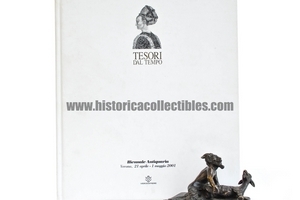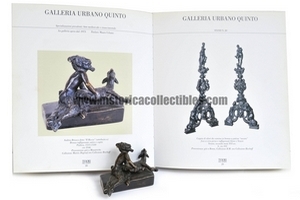Bronzetto Andrea Briosco known as Il Riccio - "Satir with Goat", circa 1515/1530
Lost wax cast bronze sculpture, cold retouched by chisel and covered with black lacquer called "dark patina", depicting Satyr and Goat in an allegorical erotic attitude. The work was created in Padua by Andrea Briosco known as "il Riccio" between 1515 and 1530.
Origin:
- Formerly in Maastricht Martin Degroof Collection
- Formerly in Maastricht Bischoff Collection
- Formerly in Novara Urbano Quinto Collection
Exhibitions:
- 2000 MIA Milano Internazionale Antiques
- 2001 Treasures of Time Verona Biennial
- 2002 The International Monte-Carlo Fine Art and Antiques Fair, principality of Monaco.
Andrea Briosco, known as Riccio, due to his thick and curly hair, was born in Trento in 1470 and died in Padua in 1532. He was one of the most important Italian sculptors.
Son of a Milanese goldsmith, Ambrogio, he trained in the workshop of Bartolomeo Bellano for whom, between 1497 and 1498, he completed the monument to Roccabonella in the Paduan church of San Francesco Grande. In the following years he was particularly active in the Basilica of Sant'Antonio di Padova, where the two bronze reliefs from 1506, preserved in the choir on the sides of the main altar, are by his hand: Christ in Limbo and David's dance before the 'Ark; the candelabra of the Easter candle which has a very rich ornamentation (perhaps his most famous work, made from 1507 to 1516), and the tomb of Antonio Trombetta, sculpted between 1521 and 1524. In his maturity, Riccio's most valuable work it was the ark of Gerolamo and Marcantonio della Torre, dated from 1516 to 1521, but it was created for the church of San Fermo Maggiore in Verona, where it is still preserved, with the exception of the bronze bas-reliefs transferred to the Louvre in 1796 . We should also remember many small bronze sculptures by him, inspired by classical subjects (putti, divinities, centaurs), which are elegant and carefully crafted. His bronze Lizards are preserved in the Amedeo Lia Civic Museum in La Spezia. Characteristic of Riccio's work is the progressive abandonment of the vigorous expressive charge of Bellanese ancestry and the parallel affirmation of an academically understood classicism, closely linked to the cultural environment of Paduan humanism. Leopoldo Cicognara remembers him in his History of Sculpture from its Risorgimento in Italy up to the century of Napoleon to serve as a continuation of the works of Winckelmann and d'Agincourt and raises him to honors as "the Lysippos of the Venetian bronzes". According to some, he was active in the planning of the Basilica of Santa Giustina. He was buried with honors in the church of San Giovanni di Verdara.




